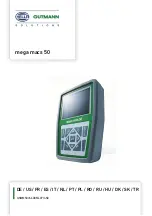
7
5. Bleeding
5.1 General notes on bleeding
of brake systems
The bleeding instructions of the
vehicle manufacturer must always
be observed and followed!
Work on braking equipment
may only be performed by mechan-
ics with the appropriate expert
knowledge and corresponding shop
equipment. Generally, the speci-
fications contained in the original
documentation of the vehicle manu-
facturer must be followed.
The illustrations on page 67 demon-
strate the basic procedure when replac-
ing brake fluids of brake system/brake
fluid replacement.
Attention: If, after bleeding, the travel
of the brake pedal is too long after
repeated firm activation of the brake
pedal or if the pressure buildup is too
„soft“, the brake system must be bled
once more according to the vehicle
manufacturer‘s instructions.
A leakage, function and action check of
the service brake system must be per-
formed after each filling, bleeding and
brake fluid replacement.
6. Disposal
6.1 Brake fluid
Used brake fluid must be collected in
a suitable collecting container (ATE
220 liter collecting container system)
separated by category. Used brake
fluid may not be mixed with other fluids
since it must otherwise be disposed off
as special waste at a high cost.
In keeping with the legal and official
waste regulations, the used brake fluid
must be brought to a waste removal or
waste recycling facility certified for this
purpose.
6.2 Containers
The brake fluid containers must be
emptied completely and disposed off
in compliance with the legal and official
waste regulations.
6.3 Unit
The unit is to be returned to your sales
partner or be disposed off in compli-
ance with the legal and official waste
regulations.
7. Storage
7.1 Brake fluid
Always keep brake fluid closed airtight
and store only in original containers.
Brake fluid must not be accessible to
children or other persons not able to
read the label and warnings.
7.2 Unit
The unit must be stored in a clean and
dry environment. The unit must be
stored inaccessible to unauthorized
persons.
8. Corrective maintenance/Repair
8.1 Unit
Corrective maintenance and repair may
only be performed by expert personnel!
8.2 Corrective maintenance/Repair
by customer service
The device must be submitted to the
sales partner. The device must be
shipped using appropriate and suf-
ficient packaging. ATE is not liable for
possible transport damages. The send-
er will pay the shipping costs.
Warranty repairs must be coordinated
directly with Continental Aftermarket
GmbH.
9. Technical data
Height:
915 mm
Width:
475 mm
Depth:
380 mm
Empty weight:
16.8 kg
Capacity:
up to 30 l
Power supply:
100–240 V AC /
50–60 Hz
Current consumption:
max. 2 A
Delivery rate of pump:
Approx. 0.9 l at 2 bar back pressure
Ranges of control:
Unit without pressure/switched off,
0.4 bar (40000 Pa),
1 bar (10000 Pa),
2.2 bar (22000 Pa)
Output of suction pump:
1 l/min
Temperature – Work area: 0° C–45° C
Automatic cut-off of pump:
at approx. 0.5 l remaining quantity
with acoustic warning
Sound pressure level:
66 dB(A)
Electrical fuse: 5 x 20 mm M 5 A 250 V
Pressure
regulator:
0–6 bar (0–600000 Pa)
Length of connecting cable:
5 m
Filling hose length:
3.50 m
Technical changes, including engineer-
ing changes, remain expressly reserved.
ATE FB 30
Operating instructions
GB
Summary of Contents for 03.9302-3005.4
Page 1: ...Bestell Nr 03 9302 3005 4 740312 BA ATE FB 30 ...
Page 2: ...ATE FB 30 ...
Page 62: ...60 ATE FB 30 Continental Aftermarket GmbH 4 1 ...
Page 63: ...61 ATE FB 30 4 1 1 ...
Page 64: ...62 ATE FB 30 Continental Aftermarket GmbH 4 2 A ...
Page 65: ...63 ATE FB 30 4 2 B ...
Page 66: ...64 ATE FB 30 Continental Aftermarket GmbH 4 2 C ...
Page 67: ...65 ATE FB 30 4 3 ...
Page 68: ...66 ATE FB 30 Continental Aftermarket GmbH 2 bar 0 bar 2 x 4 5 6 7 8 5 1 ...
Page 70: ...68 ATE FB 30 Continental Aftermarket GmbH ...
Page 71: ......










































